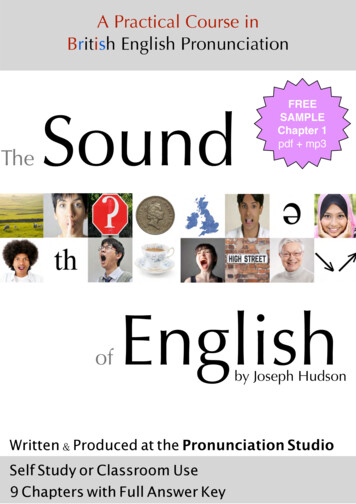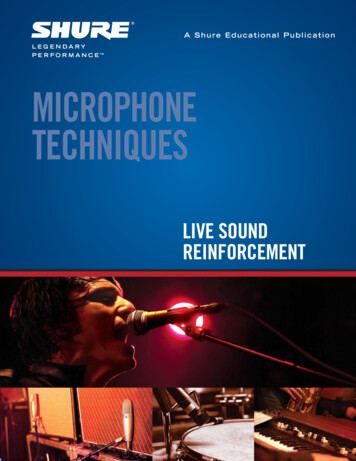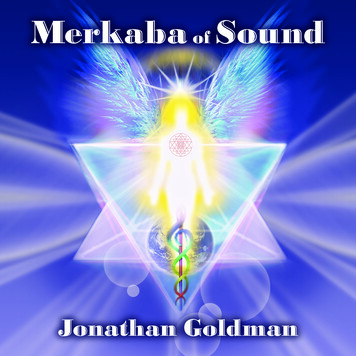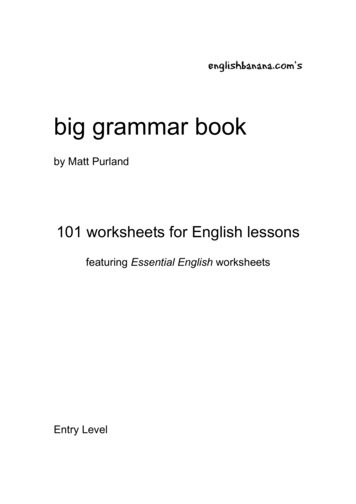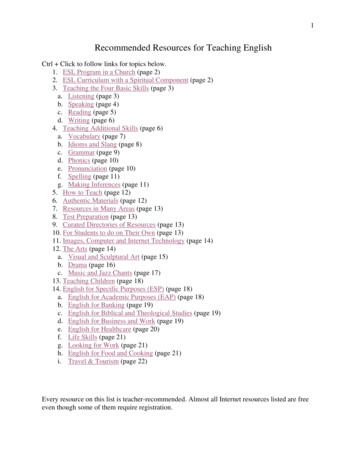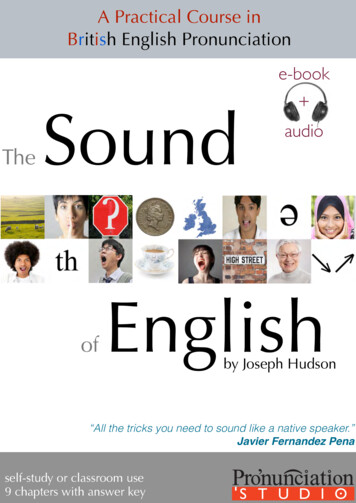
Transcription
A Practical Course inBritish English PronunciationTheSoundof3CDse-book audioEnglishby Joseph Hudson“All the tricks you need to sound like a native speaker.”Javier Fernandez Penaself-study or classroom use9 chapters with answer key
How to Use this E-Book‘The Sound of English’ is a fully interactive pdf with the following features: Audio: click on the icons next to each activity to hear the audio. Index: click on the page you require to go straight there. Answer Key: click on the question mark to go straight to the answers.Sentence Stress IntonationAudio appears with this symbolclick it to hear the file.- Listen to the following exchange.A “What would you like?”B “A cup of tea.”2.16Explanations appear in grey boxes.?- Which words are stressed?- Of the stressed words, which words are strongest?!In spoken English we stress content words.!One word in every sentence is more stressed than the others.!Normally the last content word is the most stressed word.EXERCISEExercises should be completedthen checked in the answer key.- Match the content words on the left with the content words on the right.pairpintlegAnswer Key is linked to byclicking the red question ineshoesmilkflowerslambcrisps?DRILLDrills should be repeated withthe audio until produced accurately.- Repeat the rhythm followed by each sentence from the exercise:2.17.x.X. x . X a pair of shoesVisit us at www.thesoundofenglish.org for moreactivities, news and course info!Follow us on Facebook & Twitter for updates: Joseph Hudson 2012
Introduction!!!'') ' Y' Sounds- Consonants- VowelsSpelling & ‘ghoti’Sound SchwaStructure Function & ipt IPAAnswer Key Pages 113-1144 Joseph Hudson 2012
Consonant Types Sound Consonant sounds are produced by blocking air as it leaves the mouth. This course shows you how to pronounce all 25 consonant sounds of English. Below is an example of each consonant sound - listen and read them.Type of SoundSoundExample 1Example ive(complete block of air followedby ashʒ-pleasurehhigh-affricatetʃchosecatch(plosive followed by wwall-jyellow-rroom-l/ɫlawpillfricative(constant flow of air “squeezed”through a block, sounds likefriction)(air is released through the nose)approximant(vowel-like consonant, no fullblock of air occurs)5 Joseph Hudson 2012
Consonant Articulation SoundWe use the articulators: tongue, lips & teeth, to block air. The places where we block air in English are shown below.t lY toolalveolar ŋm/p/b-f qf/vtoolC,e ,;14.t/d/l/nt lYAfθ/ð'') ' Y' 1.- Listen to the recording and match the sounds in the boxes with their articulationdiagrams (number 1 has been done). The arrows point to the place of articulation.2.3.wl il)0.2h/ʔ6.5.- Check your answers in the answer key on page 112.6 Joseph Hudson 2012
Vowels Sounds A neutral English accent has 19 vowel sounds.There are 3 types of English vowel sound - short, long and diphthong.English spelling does not always show us which sound to pronounce.We will learn how to pronounce each individual vowel sound on this course.Type of Sound0.3short(single mouthposition)long(single mouthposition)diphthong(double mouthposition)SoundSpellingsExamplesəa, e, o, ualive, the, today, supplyɪithin, sit, richʊu, oo, ouput, look, shouldee, ea, iewent, bread, friendʌu, ofun, love, moneyæacat, hand, fanɒo, arob, top, watchi:ee, eaneed, beat, teamu:ew, oo, o efew, boot, loseɜ:ir, ur, worthird, turn, worseɔ:al, aw, or, our, oortalk, law, portɑ:a, al, arglass, half, careɪay, ea, ae, aipay, great, maidɔɪoi, oynoise, toy, choiceaɪie, i e, i, yfine, like, mightəʊo, o e, oano, stone, roadaʊou, owround, how, brownɪəeer, earbeer, hear, steereəare, ere, ea, aicare, there, bear7 Joseph Hudson 2012
Vowel Articulation Sounds A vowel sound is made by shaping the mouth as air flows out. Articulators used to shape the mouth are: tongue, lips and jaw. The chart below shows examples of mouth positions in "rL rr"f,na1,na1)) ni: (keep)ɜ: (bird)y-,C"rL,na1 rr"f)ɒ (watch)DRILL- Repeat the following sentences. Notice your jaw opening each time.0.51. Keep this red bag. 2. Who took Paul’s watch?3. The bird runs fast.- Which sentence contains only rounded vowels?8 Joseph Hudson 2012
Introduction Spelling & Sound0.6- English spelling does not always indicate pronunciation.- It was famously claimed that the word ‘fish’ could be spelt ‘ghoti’ because:‘gh’ in ‘enough‘ is pronounced /f/‘o’ in ‘women’ is pronounced/ɪ/‘ti’ in ‘motion’ is pronounced /ʃ/so ‘ghoti’ could be pronounced /fɪʃ/! The pronunciation of many English sounds can be predicted by their spelling.The ‘Spelling & Sound’ section shows you how to select sounds accurately byinterpreting spelling.EXERCISE- Each group of words contains an identical spelling.- Circle the word that you think is pronounced differently from the others.loose1. goose2. noserose3. playedauthor5. paidmaidbut7. none0.7losestopped4. father6. putchooselikedNorthernsaidhutdonegone8. footbookfood9. slownowcow10. wordwork11. watchwallwornwas- Listen and check your answers.9 Joseph Hudson 2012
Schwa Spelling & Sound- Match the words below with the IPA transcription on the right:Wordaround0.8IPA cactusə!raʊnd- Which sound appears in every IPA transcription?0.9 The schwa sound /!/ can be spelt as a , e , o and u . The schwa is the most common vowel sound in English. The schwa is weak - it can never be stressed. The production of the schwa is neutral: lips, jaw and tongue are relaxed.EXERCISE- Every word in the box below contains one schwa sound.- Listen to the recording and underline the schwa in each word.0.10servantbaconpersistpicture commit alivejumper sublime London salad Peru structuresuggest soldier persuade combine balloonterror cushion scripture tighten sofa Russia- Think of any word in English with 3 syllables or more.- How many schwa sounds does it contain? Check in a dictionary.EXAMPLE: ‘conspiracy’ 2 schwa sounds.10 Joseph Hudson 2012
The Sound of EnglishFull Version140 pages 200 audio filesAvailable as a book 3CDs, ebook & iBook.Purchase
Function & Content Structure- Listen to the sentence below:“Shall we go for a walk?”0.11- Which words are stressed? Why? Spoken English is divided into function and content words. Function words carry only grammatical meaning, such as:Word Type pronouns to from for of with byare was do have could would shall cana an thesome any few allhe she it you I this thatContent words carry real meaning such as:Word Type Examplesnounsverbsadjectivesadverbscar wedding James table joymove drink turn enjoy thinkbig interesting quiet slow brightquickly quietly fortunately often againEXERCISE- In the sentences below, underline the function words:0.121.2.3.4.5.6.Can we go for a swim in the sea?It’s a beautiful day in the South of England.How do you want to pay for this, sir?Jessica Smith is required in ‘Arrivals’ immediately.When you get to the station, give me a call.Would you like some of my carrot cake?11 Joseph Hudson 2012
Schwa Function Words Structure- Read and listen to the passage below, the schwa sound is written in IPA:I’d like t! go shopping f!r ! pair !f shoes, b!t th!shops ! closed bec!se th!s ! weath!r !lert. !parr!ntlylots !f snow is coming in fr!m th! Highl!nds so th!gov!rnm!nt h!v !dvised peop!l t! stay !t home.0.13- Which function words are pronounced with a schwa sound in the passage? Many function words are pronounced with schwa when they are weak. If a function word is stressed, it can not be pronounced with schwa. Function words are always strong when said alone.DRILL- Say the word on the left alone (strong), then say it in the sentence on the right usingthe schwa sound (weak):Word Sentence(STRONG) (WEAK)0.141to /tu:/I went to work early. /tə/2are /ɑ:/What are you doing? /ə/3was /wɒz/4from /frɒm/This cardʼs from my family. /frəm/5there /ðeə/There werenʼt enough drinks. /ðə/6can /kæn/Where can we buy a map? /kən/7her /hɜ:/Her carʼs broken down. /hə/8for /fɔ:/Iʼll repeat for the last time! /fə/Was it warm in Greece? /wəz/12 Joseph Hudson 2012
Introduction Intonation- Listen to the following question being answered in three different ways:A Johnny, have you finishedyour homework?0.151. YesB 2. Yes3. Yes- Which answer (B) means i) maybe ii) definitely iii) why are you asking me? Spoken English uses 3 intonation patterns - fall, fall-rise & rise. Intonation shows us the speaker’s attitude to what they are saying.DRILL- Repeat after the recording:0.161. a) Yes b) Yes c) Yes2. a) No b) No c) NoEXERCISE- Listen to the conversations and circle the answer you hear:0.171. Are you married?Yes 2. Did you enjoy the film?Yes 3. Can you afford this meal?Yes 4. You’re drunk, aren’t you?No 5. Is this your first class?No 6. Did you eat all the chocolate? No 13 Joseph Hudson 2012
Usage Intonation Intonation shows us a speaker’s attitude to their words. This course will show you how to produce English intonation in your speech. Some important examples of intonation usage are displayed below.EXERCISE1. ATTITUDE- Listen to the following conversation twice:0.18A “Dad, I’ve got some news, I’m getting married!”B “Excellent”i) How is the father’s reaction different in each case?ii) How does he show this with intonation?2. IMPLICATION- Listen to the following conversation twice:0.19A “What did you think of the film?”B “It was good.”i) What is the difference in meaning between the two versions?ii) How is the intonation in the word ‘good’ different the second time?3. REPETITIONListen to the following conversation:0.20A “Who are you meeting tonight?”! B “Nicole Kidman.”A “Who are you meeting tonight?”! B “Not the Nicole Kidman!”- Person A says the same question twice, but the intonation is different the secondtime. How does it change and why?14 Joseph Hudson 2012
IPA Postscript- Look at the dictionary entry for the word “personally”:personally /!pɜ:sənli/- What differences do you notice between the spelt and the IPA versions?IPA (International Phonetic Alphabet) shows the way we pronounce words.In English, the pronunciation of a word often differs from its spelling, makingIPA a very useful study tool to improve your pronunciation. Stress is marked in IPA using the symbol / ˈ/.EXERCISEi) Write the words from the box below into the chart next to their IPA transcription.ii) Write the silent consonant from each word into the 3rd column.cupboard island half often write know light lamb handbag autumn0.21WordIPASilent - Listen to the recording to check your answers and practise saying the words.15 Joseph Hudson 2012
Study with the teachers who made ‘The Sound of English’in London and online. Start with a free schwa class, anindividual assessment or an online taster.Courses
Answer Key IntroductionArticulation Sounds ConsonantEXERCISE1. f/v2. t/d/l/n EXERCISE3. m/p/b4. k/g/ŋ5. θ/ð6. h/ʔ- sentence 2 ʻWho took Paulʼs watchʼ uses only rounded vowels. Spelling & Sound IntroductionEXERCISE1. choose 2. lose9. slow 10. worn3. played11. wall4. author5. said6. put7. gone8. food - around /əˈraʊnd/, manner /ˈmænə/, sailor /ˈseɪlə/, cactus /ˈkæktəs/Schwa Spelling & Sound- /ə/ appears in every IPA transcription (in bold above).EXERCISEservant persist bacon picture commit alivejumper sublime London salad Peru structuresuggest soldier persuade combine balloonterror cushion scripture tighten sofa Russia& Content Structure Function- ʻgoʼ and ʻwalkʼ are stressed because they carry meaning.- The other words ʻshallʼ, ʻweʼ, ʻforʼ, & ʻaʼ are all grammatical words used to gel thesentence.EXERCISE1. Can we go for a swim in the sea?2. Itʼs a beautiful day in the South of England.3. How do you want to pay for this sir?4. Jessica Smith is required in ʻArrivalsʼ immediately.5. When you get to the station, give me a call.6. Would you like some of my carrot cake? - Function words pronounced with schwa in the passage: ʻtoʼ, ʻforʼ, ʻaʼ, ʻofʼ, ʻbutʼ, ʻtheʼ,Schwa Function Words Structureʻareʼ, ʻthereʼ, ʻaʼ, ʻhaveʼ, ʻatʼ. - i) ʻMaybeʼ yesIntroduction IntonationEXERCISE1. 2. 3. ii) ʻDefinitelyʼ yes4. 5. iii) ʻWhy are you asking?ʼ yes.6. 113 Joseph Hudson 2012
Answer Key Introduction Intonation UsageEXERCISE1. ATTITUDEi) In the first version, the father is excited and interested, in the second he isuninterested and a little rude.ii) The fatherʼs intonation is falling in both examples, the main difference is that hestarts from a much higher pitch in the first example. This shows more emotion. In thesecond version, he starts his phrase quite low, showing disinterest.2. IMPLICATIONi) In the first version, we understand that person B really felt the film was good. In thesecond version, he is not entirely sure, he is showing reservation, we are expecting himto say something less positive now.ii) In the first version, person B uses falling intonation on ʻit was goodʼ, whereas in thesecond version he uses fall-rising intonation, known as an implicational fall-rise.3. REPETITION- The first question is asking for new information, person A does not know the answerand uses falling intonation. The second time she asks, she already knows the answer,she is repeating the question and for this reason uses rising intonation. Postscript IPA- The IPA version shows us a silent r , a long vowel /:/ and a silent a . It alsoindicates the pronunciation of the vowels /ə/ and nownəʊk (and w)5islandaɪlənds6lightlaɪtgh7cupboardˈkʌbədp (and r)8writeraɪtw9oftenɒfənt10handbaghænbægd114 Joseph Hudson 2012
‘The Sound of English’ is a fully interactive pdf with the following features: Audio: click on the icons next to each activity to hear the audio. Index: click on the page you require to go straight there. Answer Key: click on the question mark to go straight to the answers. H
